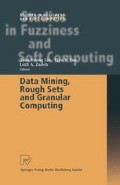Abstract
The example semantics of Inductive Logic Programming (ILP) systems is said to be in a rough setting when the consistency and completeness criteria cannot both be fulfilled together, because the evidence, background knowledge and declarative bias are such that any induced hypothesis cannot distinguish between some of the positive and negative examples. The gRS-ILP model (generic Rough Set Inductive Logic Programming model) provides a theoretical foundation in this rough setting for an ILP system to induce hypotheses that are used to say that an example is definitely positive, or definitely negative. An illustrative example using Progol is presented. Results are presented of GOLEM experiments using the data set for drug design for Alzheimer’s disease and other experiments using Progol on mutagenesis data and transmembrane domain data.
Access this chapter
Tax calculation will be finalised at checkout
Purchases are for personal use only
Preview
Unable to display preview. Download preview PDF.
References
S. Muggleton. (1991) Inductive logic programming. New Generation Computing, 8(4), 295–318
S. Muggleton and L. De Raedt. (1994) Inductive logic programming: Theory and Methods. Journal of Logic Programming, 19/20, 629–679
Z. Pawlak. (1982) Rough sets. International Journal of Computer and Information Sciences, 11(5), 341–356
Z. Pawlak. (1991) Rough Sets — Theoretical Aspects of Reasoning about Data. Kluwer Academic Publishers, Dordrecht, The Netherlands
A. Siromoney. (1997) A rough set perspective of Inductive Logic Programming. In Luc De Raedt and Stephen Muggleton, editors, Proceedings of the IJCAI-97 Workshop on Frontiers of Inductive Logic Programming, Nagoya, Japan, 111–113
A. Siromoney and K. Inoue. (1998) A framework for Rough Set Inductive Logic Programming — the gRS-ILP model. In Pacific Rim Knowledge Acquisition Workshop, Singapore, 201–217
A. Siromoney and K. Inoue. (1999) Elementary sets and declarative biases in a restricted gRS-ILP model. Informatica. To appear.
S. Muggleton. (1995) Inverse entailment and Progol. New Generation Computing, 13, 245–286
S. Muggleton and C. Feng. (1992) Efficient induction in logic programs. In S. Muggleton, editor, Inductive Logic Programming, Academic Press, 281–298
R.D. King, A. Srinivasan, and M.J.E. Sternberg. (1995) Relating chemical activity to structure: an examination of ILP successes. New Generation Computing, 13, 411–433
G.M. Shutske, F.A. Pierrat, K.J. Kapples, M.L. Cornfeldt, M.R. Szewczak, F.P. Huger, G.M. Bores, V. Haroutunian, and K.L. Davis. (1989) 9-amino-1,2,3,4tetrahydroacridin-1-ols: Synthesis and evaluation as potential Alzheimer’s disease therapeutics. Journal of Medical Chemistry, 32, 1805–1813.
A. Srinivasan, S.H. Muggleton, R.D. King, and M.J.E. Sternberg. (1996) Theories for mutagenicity: a study of first-order and feature based induction. Artificial Intelligence, 85, 277–299
A. Siromoney and K. Inoue. (1999) The gRS-ILP model and motifs in strings. In N. Zhong, A. Skowron, and S. Ohsuga, editors, New Directions in Rough Sets, Data Mining, and Granular-Soft Computing — 7th International Workshop, RSFDGrC’99, Yamaguchi, Japan, Lecture Notes in Artificial Intelligence 1711, Springer, 158–167
S. Arikawa, S. Miyano, A. Shinohara, S. Kuhara, Y. Mukouchi, and T. Shinohara. (1993) A machine discovery from amino acid sequences by decision trees over regular patterns. New Generation Computing, 11, 361–375
Author information
Authors and Affiliations
Editor information
Editors and Affiliations
Rights and permissions
Copyright information
© 2002 Springer-Verlag Berlin Heidelberg
About this chapter
Cite this chapter
Siromoney, A., Inoue, K. (2002). The Generic Rough Set Inductive Logic Programming (gRS—ILP) Model. In: Lin, T.Y., Yao, Y.Y., Zadeh, L.A. (eds) Data Mining, Rough Sets and Granular Computing. Studies in Fuzziness and Soft Computing, vol 95. Physica, Heidelberg. https://doi.org/10.1007/978-3-7908-1791-1_25
Download citation
DOI: https://doi.org/10.1007/978-3-7908-1791-1_25
Publisher Name: Physica, Heidelberg
Print ISBN: 978-3-7908-2508-4
Online ISBN: 978-3-7908-1791-1
eBook Packages: Springer Book Archive

